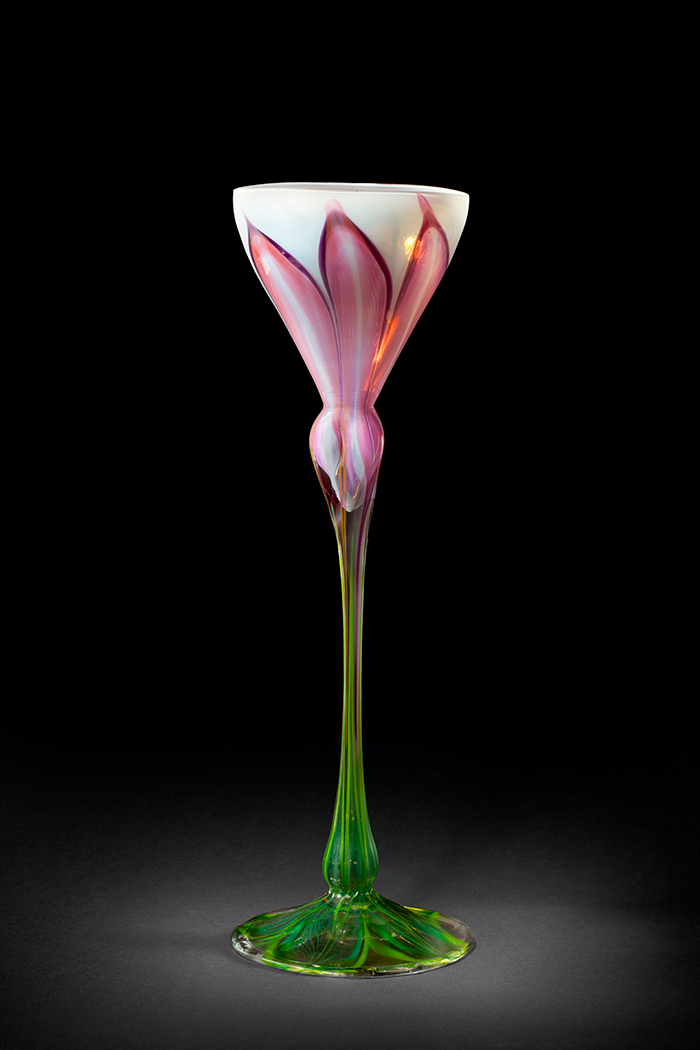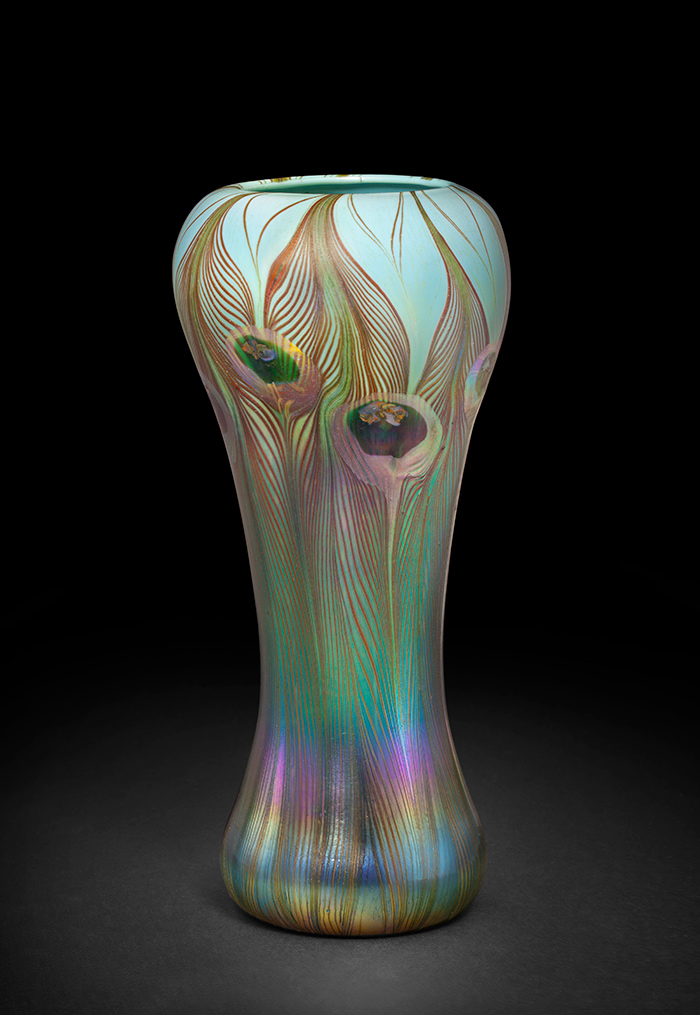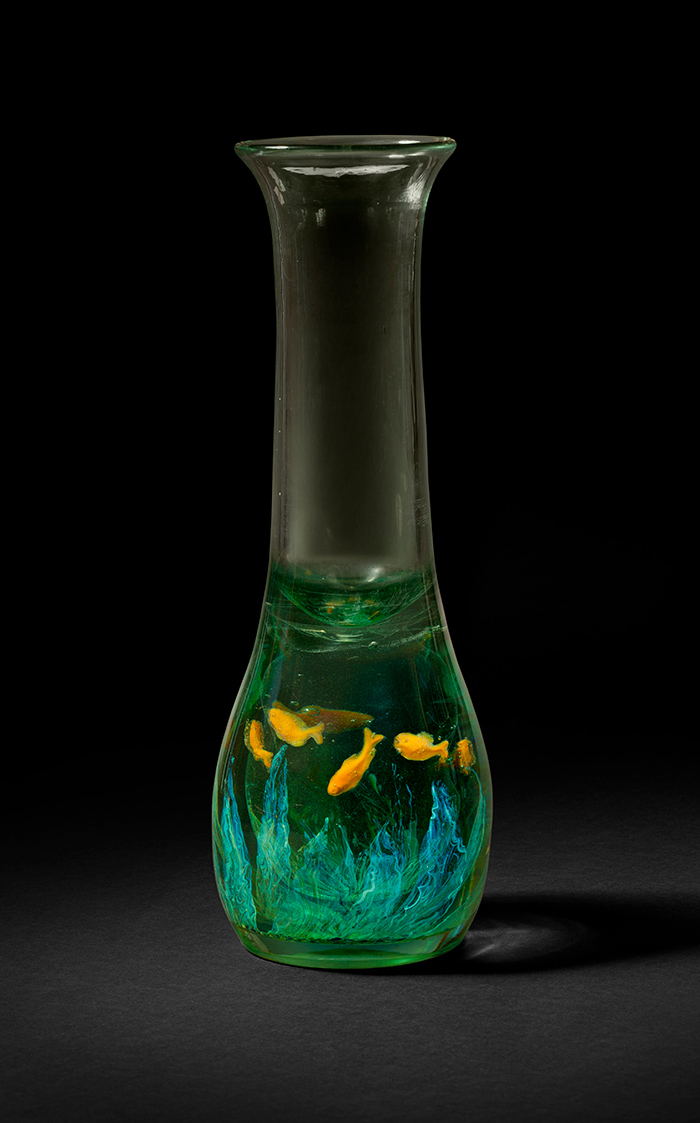The Huntington’s blog takes you behind the scenes for a scholarly view of the collections.
Tiffany: Inspired by Nature
Posted on Thu., Oct. 5, 2017 by

Tiffany Studios, Flowerform Vase, Favrile glass, 19 × 6 in. Collection of Stanley and Dolores Sirott, © David Schlegel, courtesy of Paul Doros. Image courtesy of The Huntington Library, Art Collections, and Botanical Gardens.
If you poke around in your cabinets at home, you’ll probably find some glass vases tucked away inside. You might even take them out sometimes to hold flowers picked up on a sunny, farmer’s market morning. I have a whole cabinet of these empty vessels, just waiting for their moment to shine.
Some people collect glass vases not for their utility, but for their beauty—or even their historic importance. The exhibition “Tiffany Favrile Glass: Masterworks from the Collection of Stanley and Dolores Sirott” opens Oct. 7, 2017, and continues through Feb. 26, 2018, in the Virginia Steele Scott Galleries of American Art. It features 32 historically significant glass vases designed and produced by Louis Comfort Tiffany and his team of craftspeople. (The photos in this post showcase some of my favorite items in the exhibition.)
Following his great success designing stained-glass windows, Tiffany, in the early 1890s, opened his own glasshouse in Corona, Queens, New York. There, under the leadership of English glassworker Arthur J. Nash, Tiffany’s team fashioned exquisite handmade blown-glass forms composed of Favrile glass. (Tiffany coined the name “Favrile,” taking it from the Old English word fabrile, or hand-wrought.) Tiffany’s glassmakers used a process that treated molten glass with metallic oxides, creating luminous hues within the glass.

Tiffany Studios, Peacock Vase, Favrile glass, 11 7/8 × 5 3/8 in. Collection of Stanley and Dolores Sirott, © David Schlegel, courtesy of Paul Doros. Image courtesy of The Huntington Library, Art Collections, and Botanical Gardens.
The exhibition surveys the full range of Tiffany’s Favrile glass vase production, from experimental pieces made in the 1890s to the widely admired peacock vases produced in the early years of the 20th century.
For the colors and shapes of some vases, Tiffany found direct inspiration in nature. In a vase shaped like a flower, for example, Tiffany and his craftspeople rhymed the typical form of a vase with the stem, leaves, and petals of a lily.
Tiffany’s peacock-inspired vases feature fine threads of sparkly glass, known as Aventurine glass, manipulated to mimic peacock feathers. One of Tiffany’s favorite decorative motifs, the peacock carried ancient associations with immortality and featured prominently in fancy decorative interiors of the late 19th century. This vase also shows the beautiful, multicolored iridescence perfected in Tiffany’s studios by his gaffers (a glass industry term for master craftspeople).

Tiffany Studios, Aquamarine Vase, Favrile glass, 17 1/8 × 6 in. Collection of Stanley and Dolores Sirott, © David Schlegel, courtesy of Paul Doros. Image courtesy of The Huntington Library, Art Collections, and Botanical Gardens.
Also on display is perhaps the tallest surviving example of a Tiffany vase in the Aquamarine style, which his glass studios began producing in the 1910s. Tiffany sent one of his gaffers to Bermuda in 1913 to examine marine life through a glass-bottomed boat. On his return, the Tiffany studios attempted to reproduce in glass the effect of peering through seawater.
Creating this type of vase was a two-step process. First, the decorative elements—here, orange fish flitting through seaweed—were made by heating colored glass rods and forming them into organic shapes. Then, the shapes were encased in a large mass of blue-green glass. The effect is stunning, and even more so in person.
Come by the Scott Galleries of American Art to check them out yourself. You may be inspired to find beauty in that cabinet of old vases back at home!
“Tiffany Favrile Glass: Masterworks from the Collection of Stanley and Dolores Sirott” opens Oct. 7, 2017, and continues through Feb. 26, 2018, in the Virginia Steele Scott Galleries of American Art. You can watch a video about the Aquamarine vase on display in this exhibition on YouTube.
Chad Alligood is the Virginia Steele Scott Chief Curator of American Art at The Huntington.